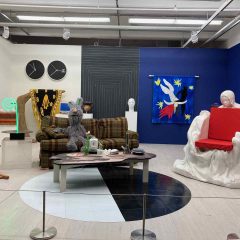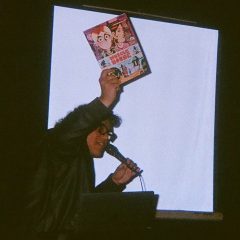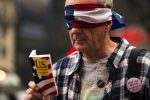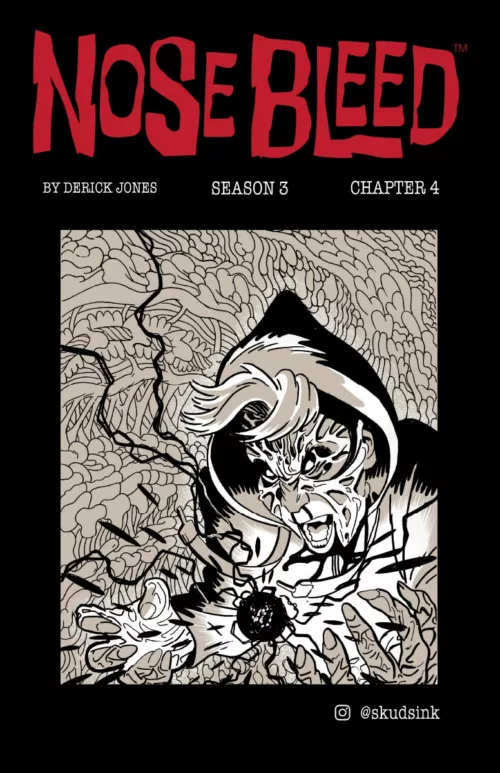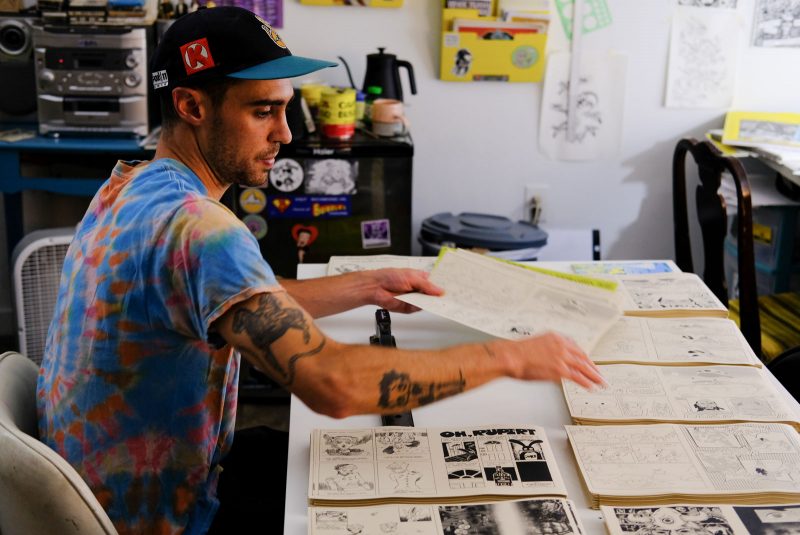
Reading Reptile House Comix is like poking around in the gutter for a half-smoked cigarette and finding a hundred dollar bill, or like stumbling outside to pee at a house show and spotting a pretty flower among all the poison ivy and beer cans. Wipe off the grime, and there’s something sparkly and beautiful underneath. Leave the grime on, though—that’s how it’s supposed to be.
Many projects have assumed the mantle of “underground comix” since the heyday of Robert Crumb’s Zap, but few have deserved it as much as Reptile House, a quarterly-ish anthology that publishes work by a diverse group of Philly artists. (One contributor, Elliot Bech, just animated the music video for Alex G’s new single, “Cross the Sea”; a full list of contributors can be found here.)
Earlier this week I met editor Nick Bunch at his studio in the basement of a former church—underground comix in the literal sense—where he was assembling Reptile House’s newest issue ahead of its release on Aug. 6. Bunch talked with me about growing up surrounded by tumbleweeds and mall goths in the “weird sci-fi landscape” of Tucson, Arizona; transitioning from experimental art films to comics; and playing classical guitar tapes for his printer. Our conversation has been edited for length and clarity.
Partners and Son, the comic store and art gallery at 618 S 6th St., will hold a release party for Issue 10 of Reptile House on Saturday, Aug. 6, from 6-9 p.m.

Tasso Hartzog: Tell me about how Reptile House got started.
Nick Bunch: A couple friends of mine were running drawing meetups at a coffee shop in South Philly. And two of the people that would normally go were [Reptile House contributors] Tia Roxae and MechanicalPencilGirl. We had been talking for a while about doing some sort publication, and I really had no clue what that meant. I didn’t even have any concept of what a comic anthology was.
MechanicalPencilGirl actually knows more comic history than I do and introduced me to stuff like Zap and Raw and Heavy Metal. I was like, Oh, there’s this really cool history to this, coming from underground comics in the sixties. Those first issues of Zap that she showed me really blew my mind and opened the door to what I thought this could be.
So we eventually had a few meetings and put together a group of artists. And out of that we put together the first issue in December, 2019, which was only a 50-copy run. I had no clue what we were doing. We were printing it on a super tiny laser printer in my house, and it was awful. But we pulled it together.
TH: So you were making comics in some capacity at the time.
NB: I was making comics, but I really had no idea what I was doing. I wasn’t even that into comics. I had no clue what was out there.
TH: If you didn’t know all this history, how did you start making comics and why?
NB: I moved here from Boston, and in Boston I was doing this sort of dumb film art stuff, like 10 minute films on 16 millimeter that had no narrative or story. I was storyboarding ideas for more narrative stuff, and that got me thinking that maybe the storyboards were the actual final product as comics. Also, in comics it’s way easier to get a sense of humor across, instead of doing really pretentious film art stuff. They weren’t funny, and I feel like that was really missing from the art that I was doing prior to comics. Now the humor is maybe the center.
TH: It sounds like you totally stumbled into making comics.
NB: I grew up with a cool uncle who took me to the comic book store and got me into Spawn and this was the mid nineties, so Spawn was cool. The band Kiss had a comic at the time that was really disgusting and good and I loved that. But then he got me into Bone. Bone’s the best. That was at a very early age. And then I dropped off from comics after that for probably 14 years, 15 years.
TH: Where did you grow up?
NB: I’m from Tucson, Arizona. The new comic I’m working on is about two idiot juvenile delinquent rats that grow up in what is essentially Tucson and get in a bunch of trouble. So I’ve been thinking about the desert a lot and growing up in this weird sci-fi landscape.
TH: In your comics you put a lot of attention into the backgrounds. The settings are really intricate.
NB: Yeah, for sure. Up until now, all this stuff I’ve been doing for Reptile House has taken place in Philadelphia. And I do pay attention to very specific neighborhoods, which is for my own benefit and also for local readers. Setting is super important to me.

TH: I feel like you have a very recognizable visual style and writing style. Where did those come from?
NB: I really have no idea. I hope there’s a style to it. The writing really just happens. I’ll smoke weed, go for a bike ride, and conversations between the characters will pop up into my head, and I’ll try to write those down. I hope there’s a style to the writing.
TH: I think so. There’s social commentary in there. It’s under a few layers of humor and sarcasm, but the stuff about cops and drugs and Kensington—it’s social satire.
NB: That’s definitely stuff I’m thinking about. For me, that stuff just writes itself because it’s already floating around in my head.
TH: Yeah, it all feels very true. It’s fictionalized but rooted in a place and a group of people and a culture.
NB: Yeah, definitely. It’s when you latch on to these groups or genres or music scenes, and the dramas that unfold within these scenes.
TH: Is music a big thing for you?
NB: Oh, for sure. I grew up a bad kid in the desert, but I was also a nerd. So I was definitely on the Weezer side of things, but I was getting into trouble with all the nu metal kids. With this new comic [Desert Rats], I’m revisiting and thinking about Tool t-shirts and Korn t-shirts and the aesthetic from back then. Tripp pants and shoplifting from Hot Topic.
TH: It seems like you’re really into what defines a scene or what kind of symbols create a culture, whether that’s music or a logo or clothing.
NB: It is funny, back then if you were a mall goth, or if you were wearing a slip knot shirt, it meant a certain thing. The Korn shirts, the Tool shirts, the Disturbed shirt. All that stuff meant you were part of a specific group.
TH: With all the logos and band tees in your work, it seems like you’re also really into typography.
NB: I f•••ing love fonts. I’m thinking about lettering and fonts all the time. That’s a huge, huge thing for me. It’s like a picture. It should be just as important as the comic panel.
TH: How does the structure of Reptile House work? And how does it all get done?
NB: It’s so messed up. There’s no structure at all. I’m a terrible editor and a terrible manager. Each issue that we put out, I’m tearing my hair out and I’m like, “Next issue, we’re gonna figure out a better way.” This time was actually good. I set a hard deadline and everyone made it. It was great. And that hard deadline was two weeks out from the release. That gives me three days to do all the layouts and then that gives me a full week to print all the in-house issues.
Usually it’s not this smooth. Usually I’m printing on the Friday before the Saturday release. The past two or three issues I’ve had a bunch of help from Shane Olsen and Nicole Rodrigues, who are both contributors. They’ve been coming into the studio, helping me staple and fold.
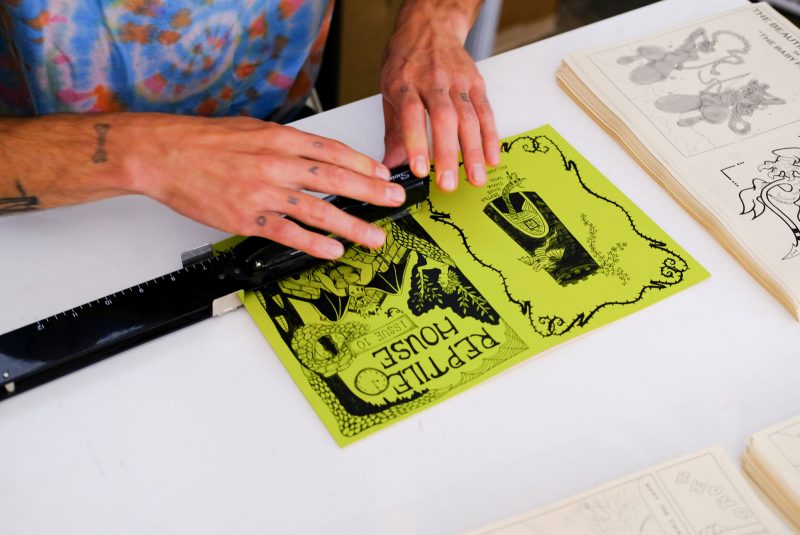
TH: You’re holding a bone folder right now. And you’ve got a stapler in front of you.
NB: Yeah, yeah, these are the two items I live by.
TH: Your sword and shield.
NB: They’ll never die. They’re made to last for ever and ever. I’m really superstitious too. I have two tapes in here—Andrés Segovia classical guitar tapes. When the printer’s running I will only play those, ’cause I’m convinced that the printer likes to listen to Andrés Segovia.
TH: It’s like playing music for plants.
NB: Yeah, yeah, exactly. I feel like everything just runs smoother.
TH: As editor, do you prompt the artists at all? The stories in Reptile House cover lots of themes and styles; do you have any influence on that?
NB: No, there’s no prompt at all. We try to ask artists who do weird stuff that would fit in with the underground comics theme we’re trying to create. I’m sort of anti telling people what to do. They should just do whatever they want to work on.
TH: What else is in the future for Reptile House?
NB: Right now I’m just trying to get through this week. On Saturday we’re releasing issue ten and Nicole’s two-color riso book Blank Frames. And then after that We want to put out another issue in December before the new year. We’re trying to put out a special issue around March. Maybe bring in some non Philly artists for the first time and have a more intentional anthology.
TH: What personal projects are you working on?
NB: I’m working on this thing called Desert Rats. some of the stories from that will be serialized within Reptile House. I probably have almost a hundred or 200 pages worth of stories written out in notebooks. But that takes so much time, putting it into comic form. That’s the big project I’m working on right now. Idiot rats shoplifting in Tucson, Arizona.
TH: Sounds great. Any work by other artists that’s exciting you right now?
NB: One of our contributors, Rob Woods, has started putting out an anthology called A+Plus Comics. Rob Woods is one of my favorite artists of all time. We’re also always looking at what Nate Garcia is putting out. He can pump out comics like no other.
TH: It’s crazy.
NB: It’s incredible, I wish I could do it like that. I’ve been buying a bunch of stuff from Carlos Gonzalez. He puts out really weird comics that I love. The other stuff I’m collecting right now is Alex Graham‘s new books. Anything Inés Estrada puts out I buy, and all those Mexico city artists like Abraham Diaz. We met this really cool person in Toronto, Gabriel Howell, and I’m really excited about their stuff. It’s gorgeous. Like the most gorgeous stuff that’s coming out right now.



